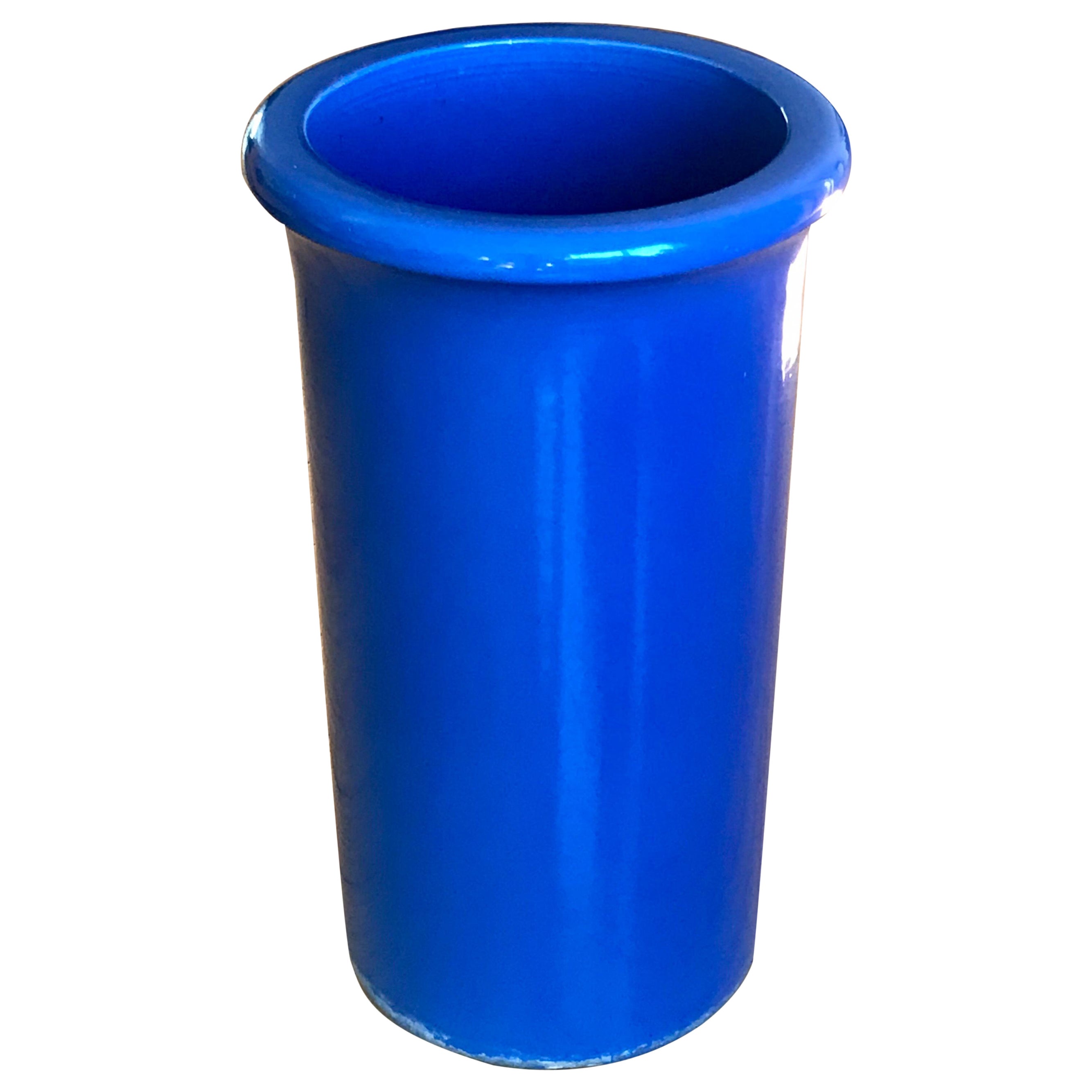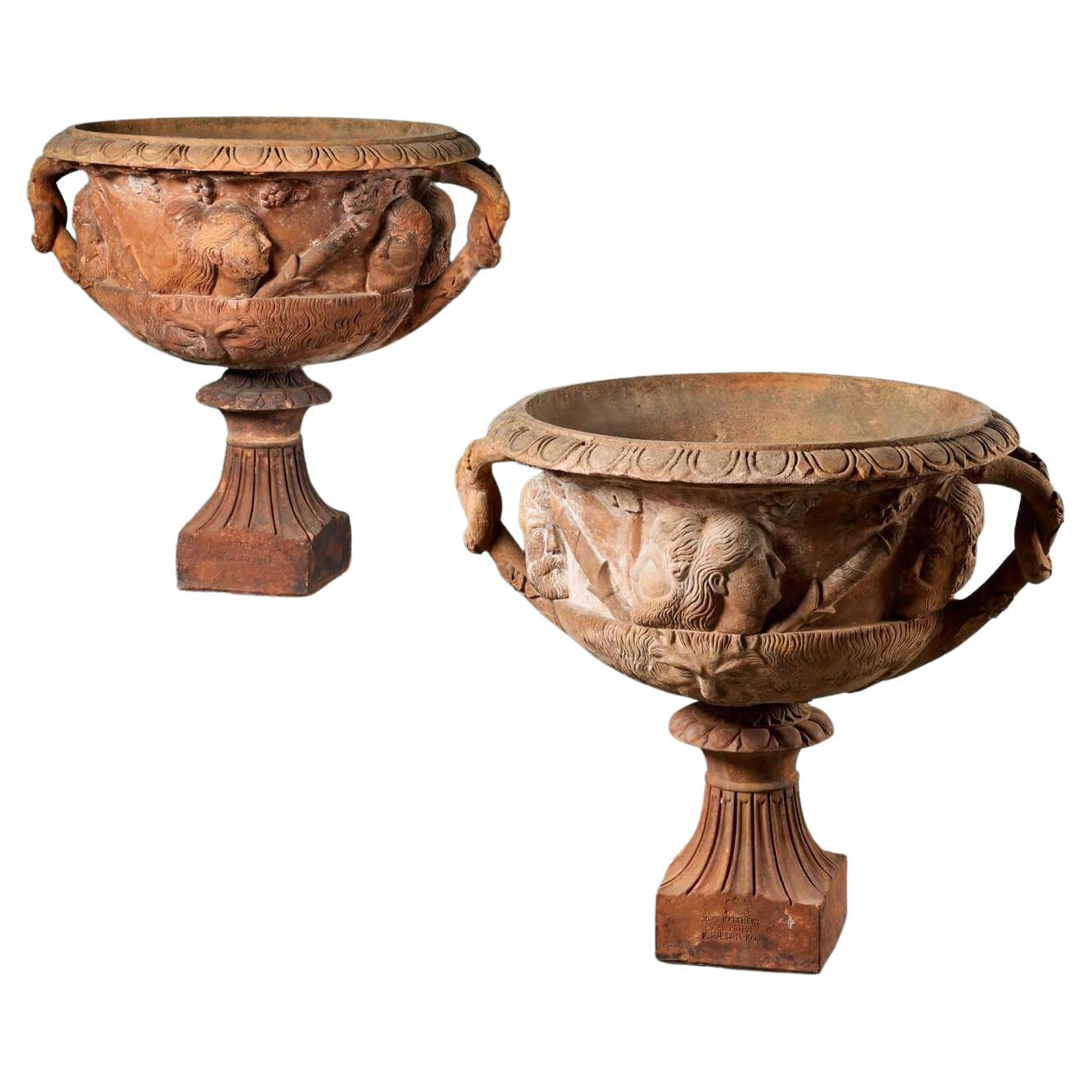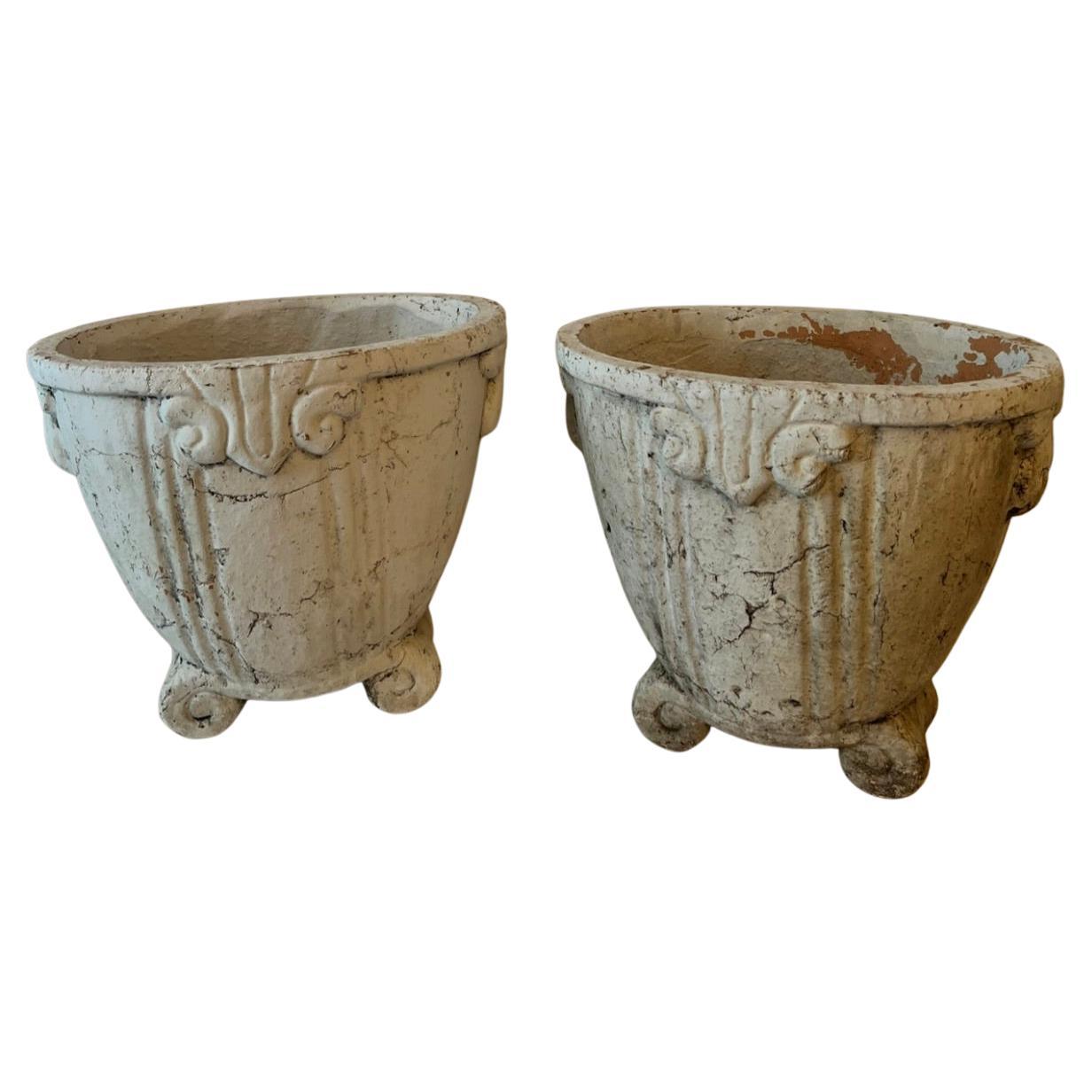Items Similar to Pair Rare John Campbell Terracotta Chinoiserie Planters or Umbrella Stands
Video Loading
Want more images or videos?
Request additional images or videos from the seller
1 of 20
Pair Rare John Campbell Terracotta Chinoiserie Planters or Umbrella Stands
About the Item
An exceptionally rare pair of John Campbell planter pots. The design is attributed to John Cambell's son, Rupert John Campbell.
John Campbell produced decorative pots at his brick works and pottery in Launceston, Tasmania from 1880 until 1975. Rupert John inherited his father's works and was a skilled artisan and potter. He developed presses for decorative pottery.
This beautiful pair of jardinières likely date to the early 1900s. They were passed down through three generations. The original owner gave them to her son. In the 1980s the (then elderly) son gifted them to a friend (the last owner before this sale). At the time they received them they were made aware of their age and rarity. Now, another forty years later, they are potentially the only pair in existence.
Only one similar John Campbell un-glazed terracotta 'umbrella stand' can be found on record. It was sold in 2008 in Tasmania, at a 'Fine Colonial Decorative Arts' auction run by Mossgreen Auctions, a reputable auction house, though since closed. I can find no other reference to this model, except an acknowledgement of the existence of an un-glazed terracotta umbrella stand, in the definitive record of Campbell's work by Kevin Power, 'John Campbell Pottery: Recollections and Collections' published 2014.
These are of the same design and size but were manufactured with drainage holes in the base. They were clearly decorated using a press but the clay slabs were pushed into the press by hand. The interior of each pot shows the marks of hammers used to force the clay into the face of the press pattern. They have a hand-crafted appearance, with hand finished mould lines to each side and there are pressing faults apparent in various areas of the pattern.
Tasmania was notably independent in production of most household goods, due to the isolation of the colony right up until the turn of the 19th century. Being at the farthest reaches of the British Empire, settled as a penal colony, with a relatively low consumer population, it was not a market for the high-volume import of domestic goods.
As a consequence, household wares and decorative pieces produced in Tasmania through the 19th century represent a wholly independent category of Australian colonial design, production and craft. These pots are highly collectable and scarce artifacts of one of Tasmania’s earliest industries.
In aesthetic terms, many Tasmanian artifacts are notable for following British, Georgian and Victorian fashions but with a colonial character of their own devising. Local characteristics became a stronger feature of Tasmanian decoration over time. Note the classical Georgian/Victorian chinoiserie motif of a bird foraging among rushes. In this case, the local interpretation depicts a Brolga (the largest Australian wetland bird) foraging amongst native Australian reeds and water lilies.
Another of the things that sets early Tasmanian artifacts apart is the way in which necessity forced artistic production in pottery to be less refined than that of their British counterparts. A broad range of products had to be produced to meet local requirements, often by a single producer.
John Campbell’s pottery is a great example of this practical necessity. It produced everything from industrial drainage pipes and bricks to household pottery and decorative items, all from a relatively small family run factory. Their domestic wares were so well trusted and appreciated that they by the 1940s they made their way all over the mainland of Australia.
Under these circumstances, the refinement of decorative technique was not as great a priority as utility, consistent quality of production and durability. As a consequence, Australian colonial works and their early 20th century descendants such as these pots, are hugely appealing. They have an idiosyncratic and vernacular appearance, with British and European stylistic trends of their day overlaying a base of inventiveness, local interpretation and sturdy functionality.
We hope you can appreciate the rarity and significance of this well-preserved pair of planter pots (or can be used as umbrella stands). They can be counted amongst Tasmania’s most significant and collectable domestic decorative pottery.
They are particularly deserving of preservation in an Australian collection, so we are offering free delivery anywhere in Australia.
- Dimensions:Height: 20.48 in (52 cm)Diameter: 11.82 in (30 cm)
- Sold As:Set of 2
- Style:Chinoiserie (In the Style Of)
- Materials and Techniques:Terracotta,Pressed
- Place of Origin:
- Period:
- Date of Manufacture:1930
- Condition:Wear consistent with age and use. Minor losses. Chips to the feet of both pots, some old, some more recent. Salt florescence to exteriors. Pitting notable on the pot pictured to the right. Interiors soil stained. Used but in remarkably good condition for their age.
- Seller Location:Melbourne, AU
- Reference Number:1stDibs: LU2656338418582

About the Seller
5.0
Gold Seller
These expertly vetted sellers are highly rated and consistently exceed customer expectations.
Established in 2013
1stDibs seller since 2017
138 sales on 1stDibs
Typical response time: <1 hour
- ShippingRetrieving quote...Ships From: Melbourne, Australia
- Return PolicyA return for this item may be initiated within 14 days of delivery.
More From This SellerView All
- Set of Ten Original Mid-Century Earthenware Terracotta Planter Pots, 1950sLocated in Melbourne, AUOriginal midcentury earthenware terracotta pots, approximately 5.3 inches/13.5cm diameter and 5 inches/13cm high with lovely colour variations ...Category
Vintage 1950s Australian Mid-Century Modern Planters and Jardinieres
MaterialsEarthenware, Terracotta
- Very Large Brutalist Middle Eastern Ceramic Planter 1970sLocated in Melbourne, AUThis wonderful footed earthenware planter can be used as a vase or bowl. It presents as an impressive object in it's own right, or can be used as a plant pot holder. Based on ancient Middle Eastern hand-building and mineral glazing techniques, it has wonderful Organic Modern styling potential, but will also interest those who like ancient pottery and/or the Brutalist aesthetic of the 1970s. It was purchased in the late 1960s or early 1970s from Israel by a dedicated collector of ceramics for use as an Ikebana vessel, and shipped to Australia...Category
Vintage 1970s Israeli Brutalist Vases
MaterialsEarthenware
- Zaccagnini Majolica Planter, circa 1950By Urbano Zaccagnini, Mario BandiniLocated in Melbourne, AUA handcrafted plant pot holder by the Zaccagnini pottery. This lovely piece is styled as a cylinder of plain white columns under a plain edge, sporting two highly detailed bunches of...Category
Vintage 1950s Italian Mid-Century Modern Decorative Baskets
MaterialsTerracotta
- Empoli Scandinavian Style Mixed Cased Glass Bottle or Gulvase, 1970sBy EmpoliLocated in Melbourne, AUA unique Empoli cased glass gulvase type vessel. After checking with eminent glass collectors, this has been identified as Italian glass from Empoli...Category
Vintage 1970s Italian Scandinavian Modern Vases
MaterialsArt Glass
- Large Wide Based Brutalist Middle Eastern Earthenware Lamp Base, 1970sLocated in Melbourne, AULarge and wonderfully shaped earthenware lamp is fully wired, tested and tagged safe for use. It’s a coil pot construction in the style of Dan Arbeid. The wid...Category
Vintage 1970s Israeli Brutalist Vases
MaterialsEarthenware
- Very Large Saggar Fired Burnished Clay Vessel, 1980s, Jill SymesLocated in Melbourne, AUA very large and appealing Saggar fired vessel, made by Australian potter, Jill Symes. Signed, with original stickers and leaflet. This beautiful pot has ...Category
Vintage 1980s Australian Organic Modern Urns
MaterialsClay
You May Also Like
- Tall Planter or Umbrella Stand Architectural Pottery David CresseyBy David CresseyLocated in Los Angeles, CACalifornia design Nice fluted form Bisque clay with elegant royal blue gloss glaze Only a few of these were made / ordered for office buildings and or residential From Group Artec - ...Category
Late 20th Century American Modern Planters and Jardinieres
MaterialsCeramic
- Two Antique John Matthews Terracotta PlantersLocated in Wormelow, HerefordshireA very rare pair of antique terracotta Warwick vases circa 1880 with socles stamped ‘John Matthews Royal Pottery, Weston Super Mare’ and embellished with a royal crest. These 140-year-old garden vases have a lightly weathered appearance, making a characterful addition to any garden or interior. In the 19th century, Weston-super-Mare was home to a thriving pottery industry. In 1847, Charles Phillips...Category
Antique Late 19th Century English Georgian Planters, Cachepots and Jardi...
MaterialsTerracotta
- Pair of Italian Glazed Terracotta Urns or PlantersLocated in Houston, TXPair of Italian glazed terracotta urns or planters. This stunning pair of Italian glazed terracotta urns, planters or jardinieres are from the A...Category
Vintage 1940s Italian Art Deco Urns
MaterialsTerracotta
- Pair of Patinated French Terracotta Planters or JardinieresLocated in Los Angeles, CAA pair of French terracotta planters or jardinieres. The pair were painted some time ago and have a wonderful patina. They look to have an art deco pattern and would be a complimen...Category
20th Century Planters, Cachepots and Jardinières
MaterialsTerracotta, Paint
- Pair Oversize Chinoiserie Porcelain Planters on Hexagonal Wood StandLocated in Locust Valley, NYA pair of oversize chinoiserie painted porcelain planters on hexagonal curved wood stands. The vintage porcelain fish bowl jardineres are decor...Category
20th Century Asian Planters, Cachepots and Jardinières
MaterialsPorcelain, Wood
- John Follis & Rex Goode Rare Sombrero Planter in Terracotta, Circa 1950'sBy John Follis, Architectural Pottery, Rex GoodeLocated in Los Angeles, CAJohn Follis & Rex Goode Sombrero Planter for Architectural Pottery, circa 1950's. Very rare unglazed terracotta. The AP catalog shows this piece as Model M-109. We have 2 of the...Category
Vintage 1950s American Mid-Century Modern Planters, Cachepots and Jardin...
MaterialsTerracotta
Recently Viewed
View AllMore Ways To Browse
Vintage Planter Stands
White Planters 50s
Tole Flower Arrangement
Blanc De Chine Planter
Lip Gloss Cameo
Silver Nautilus Planter
Vintage Metal Milk Container
Vintage Metal Milk Containers
Vintage Milk Container Metal
Antique Hip Baths
Antonio Zen Nove
Beatriz Potters
Chalmont Hector
Charles Noke On Sale
Chinese Export Bough Pots
Chris Spanovich
Church Italian Antique Floor Lantern
Clement Massier On Sale





